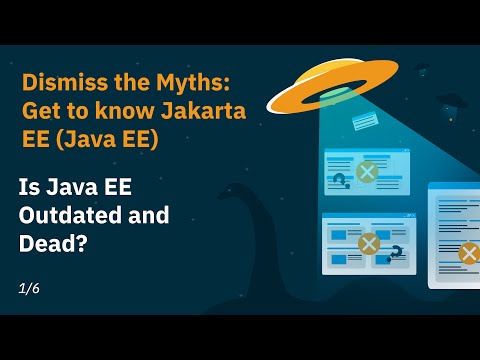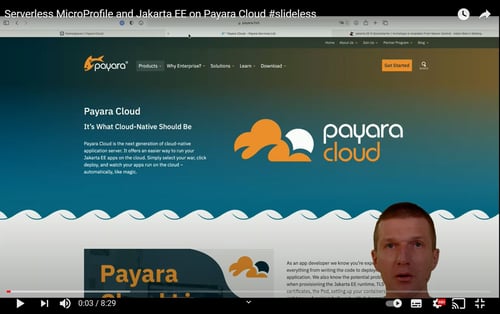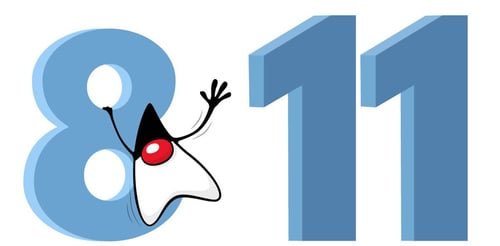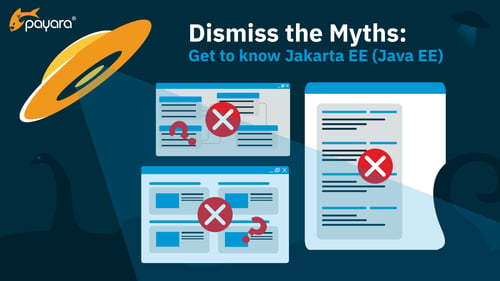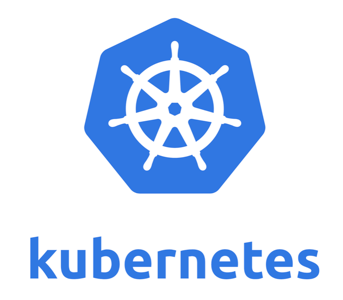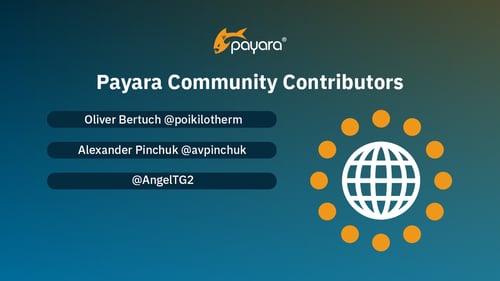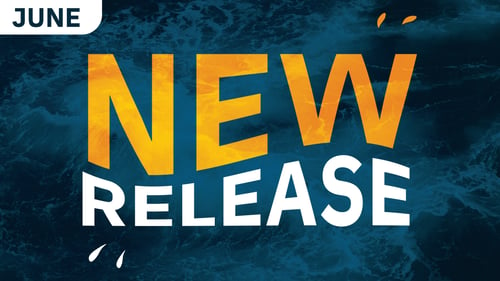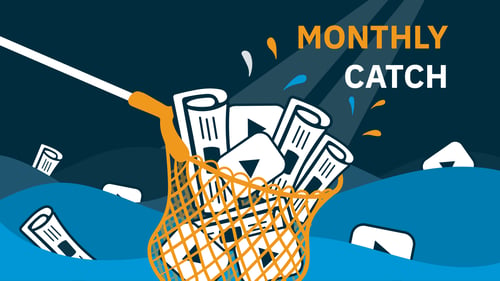Archive from June 2021
Is Java EE Outdated and Dead? Watch The Video.
Published on 30 Jun 2021
by Priya Khaira-Hanks
Topics:
Java EE,
JakartaEE,
Java
|
0 Comments
We are almost halfway through our summer webinar series! Across 6 online events, our CEO and FounderSteve Millidgeis discussing common misconceptions aroundJava. He's broken down false views of the programming language, and its enterprise-orientated iteration Jakarta EE, into 6 topics - tackling them one by one and showing that Java is still relevant.
Each session is concise - around 30 minutes - and you don't need any previous knowledge of Java or Jakarta EE.
Watch Adam Bien Trial Payara Cloud! (Video)
Published on 24 Jun 2021
by Priya Khaira-Hanks
Topics:
Cloud,
Payara Cloud
|
1 Comment
Adam Bien is a well-known expert in the world ofJakarta EE. He is a freelancer, author, Java Champion andblogger, providing resources and training materials, and is host of theAirHacks.FM podcast - where he regularly talks to the leading experts in the Java and Jakarta EE community, with recent guests including PayaransLenny PrimakandRudy De Busscher.
As a long time user of the Payara Platform - regularlyrecommending it as a solution to GlassFish problems - we were keen to offer him a trial ofPayara Cloud, our next generation of cloud-native application runtime. Payara Cloud offers an easier way to run Jakarta EE apps on the cloud, allowing you to simply select your war, click deploy, and watch your apps run - automatically, like magic!
As part of our Payara Cloud Closed Beta testing, we offered him a trial of the software. He created a concise video showing his experience using serverless MicroProfile and Jakarta EE on Payara Cloud. Watch it now to find out what his first thoughts were in his own words.
Create a Jakarta EE 8 Web App with Payara Server and Your Favorite IDE
Published on 22 Jun 2021
by Debbie Hoffman and Rudy De Busscher
Topics:
Payara Server 5,
JakartaEE,
getting started with Jakarta EE
|
0 Comments
How to Update An Application Using JAXB from JDK 8 to JDK 11
Published on 18 Jun 2021
by Rudy De Busscher
Topics:
JDK 8,
Payara Platform,
JDK 11
|
1 Comment
The Java Architecture for XML Binding (JAXB) framework is used to easily convert between XML and Java class instances. You just have to define some annotations on the Java classes and properties and the framework uses those definitions to convert between them. But is also heavily used within the Java EE specification Java API for XML Web Services (JAX-WS) that implements the support for SOAP messages within Java Enterprise.
Are GlassFish and Payara Server the Same?
Published on 16 Jun 2021
by Debbie Hoffman
Topics:
GlassFish,
GlassFish Migration,
Payara Enterprise
|
0 Comments
When commercial support for GlassFish ended in 2014, Payara Server was created from the open source code as a fully supported drop-in replacement for GlassFish.
Payara Services was born in 2016 to offer support solutions for Payara Server. By 2017, Payara Services had joined The Eclipse Foundation and the Payara Platform expanded to include Payara Micro and comprehensive commercial support options for development projects, in-production support, and consultancy solutions. New product features and the development of the Payara Platform evolves and is improved upon with each monthly release, and while the application server was originally derived from GlassFish and shares many similarities - the two products are not the same.
New Webinar Series! Dismiss the Myths: Get to Know Jakarta EE
Published on 14 Jun 2021
by Priya Khaira-Hanks
Topics:
Java EE,
JakartaEE,
getting started with Jakarta EE
|
0 Comments
Last week, we announced our exciting new webinar series, 'Dismiss the Myths: Get to Know Jakarta EE (Java EE). This is a series of 6 webinars, every Wednesday at 3.00pm BST for the next 6 weeks - with the first one taking place this Wednesday!
Our CEO and FounderSteve Millidge is leading this series, taking one common misconception about Jakarta EE ( previously Java EE ) at a time. Turns out, you might be wrong in thinking Java is behind the times...
This is also the perfect webinar series if you have heard Jakarta EE or Java EE mentioned but aren't sure what it is, what the namespace change means or where its future lies. Steve will be catering to users who are new to the technology as well as long-time Jakarta EE developers.
Do You Really Need Kubernetes?
Published on 09 Jun 2021
by Rudy De Busscher
Topics:
Cloud-native,
Kubernetes,
Containers,
Payara Cloud
|
0 Comments
These days, it seems Kubernetes is a topic that is never too far from people's lips. The tool, and the associated tools built around it, are talked about so often it seems it's the only subject important to developers these days - especially as the IT world becomes increasingly orientated towards cloud and microservices.
But in spite of all the conversation around Kubernetes... do you really need Kubernetes for your environment? Or is it just another case of the next 'new and shiny' object, with people distracted by the novelty and possibility, rather than the facts? In this blog, I'll take a closer look at why Kubernetes might be a case of the hype outweighing the helpfulness in most cases.
Shape The Future of Payara Platform Through GitHub
Published on 07 Jun 2021
by Priya Khaira-Hanks
Topics:
New Releases,
Payara Community
|
1 Comment
Payara Platform is an open source middleware platform. This means that we are proud to nurture and grow an open and collaborative community, building on the needs of all to advance our software.
Part of this ethos is inviting contributions to our software via our GitHub. Users can issue a pull request with suggested bug fixes and enhancements, and if successful, these will incorporated in our next release. We send t-shirts and stickers to contributors to say thank you!
Since our last contributor shout out in February, we've implemented many useful pull requests, from valued long time contributors Alexander Pinchuk and Oliver Bertuch, as well as new contributorAngelTG2.
We also wanted to take the opportunity to point out that contributions aren't the only way to shape the future of Payara Platform. You can also up or down vote the open issues - new features, enhancements and bug fixes - that would make the most positive difference to YOUR development and applications. Find out more below.
Introduction to New AutoScale Feature Available in Payara Server
Published on 04 Jun 2021
by Rudy De Busscher
Topics:
New Releases,
AutoScale
|
0 Comments
Running your application sometimes requires multiple instances to handle the requests of the users. Within the Payara Platform, the Domain Data Grid helps you configure your environment to run your application in a cluster. Besides the setup of a cluster itself, many applications can benefit from an environment that scales dynamically.
The number of instances must increase when the application usage peaks and should decrease when activity is low to reduce the resource usage and the corresponding costs associated with it. The introduction of the AutoScale feature in Payara Server Community 5.2021.4 helps us achieve this dynamic scalability.
What's New in the June Payara Platform Release?
Published on 02 Jun 2021
by Debbie Hoffman
Topics:
What's New,
New Releases,
AutoScale
|
0 Comments
The June 2021 Payara Platform release is here! Payara Enterprise 5.28.1 includes 5 bug fixes and 2 component upgrades along with a community contribution from AngelTG2 for improving loading time for REST applications when there are many password aliases.
In addition to the bug fixes, component upgrades, and community contribution improvement, the Payara Community 5.2021.4 release also introduces a new AutoScale feature in Payara Server to achieve dynamic scalability of instances based on application usage.
You can download Payara Platform Community 5.2021.4 here and request Payara Platform Enterprise 5.28.1here.
Read more below to find out the details.
The Payara Monthly Catch for May 2021
Published on 01 Jun 2021
by Priya Khaira-Hanks
Topics:
Java EE,
MicroProfile,
JakartaEE,
news and events,
Java
|
0 Comments
The big community news of this month was the release of Jakarta EE 9.1! The Eclipse Foundation brought out Jakarta EE 9.1 Platform and Web Profile specifications and related TCKs - the first release since the breaking namespace change to jakarta. We've rounded up our articles & announcements on this subject below - and watch this space, as Payara Platform is very close to launching our own Compatible Implementation.
We also released the results of our Payara Platform Survery 2021 . Read in fullhere, including what we've learnt about the infrastructure you are using with the Payara Platform, what features you want to see, and our findings on how our users are adopting MicroProfileAPIs and new Jakarta EE versions.
We're already using the results of the survey to shape content that responds to recurring issues users are encountering. See Rudy'sblog on why you might be finding Payara Server slow and an easy fix you may not have tried, as issues with deployment speed was a common theme in our survey results.
As well as Payara's own content, the 'Monthly Catch' also includes our pick of the best from Java EE/Jakarta EE, MicroProfile, Java SE and DevOps influencers and authors this month, and wider industry news. We hope you enjoy, and make sure you are following us onLinkedIn and Twitter, and signed up to our blog, to get this content as it comes!
